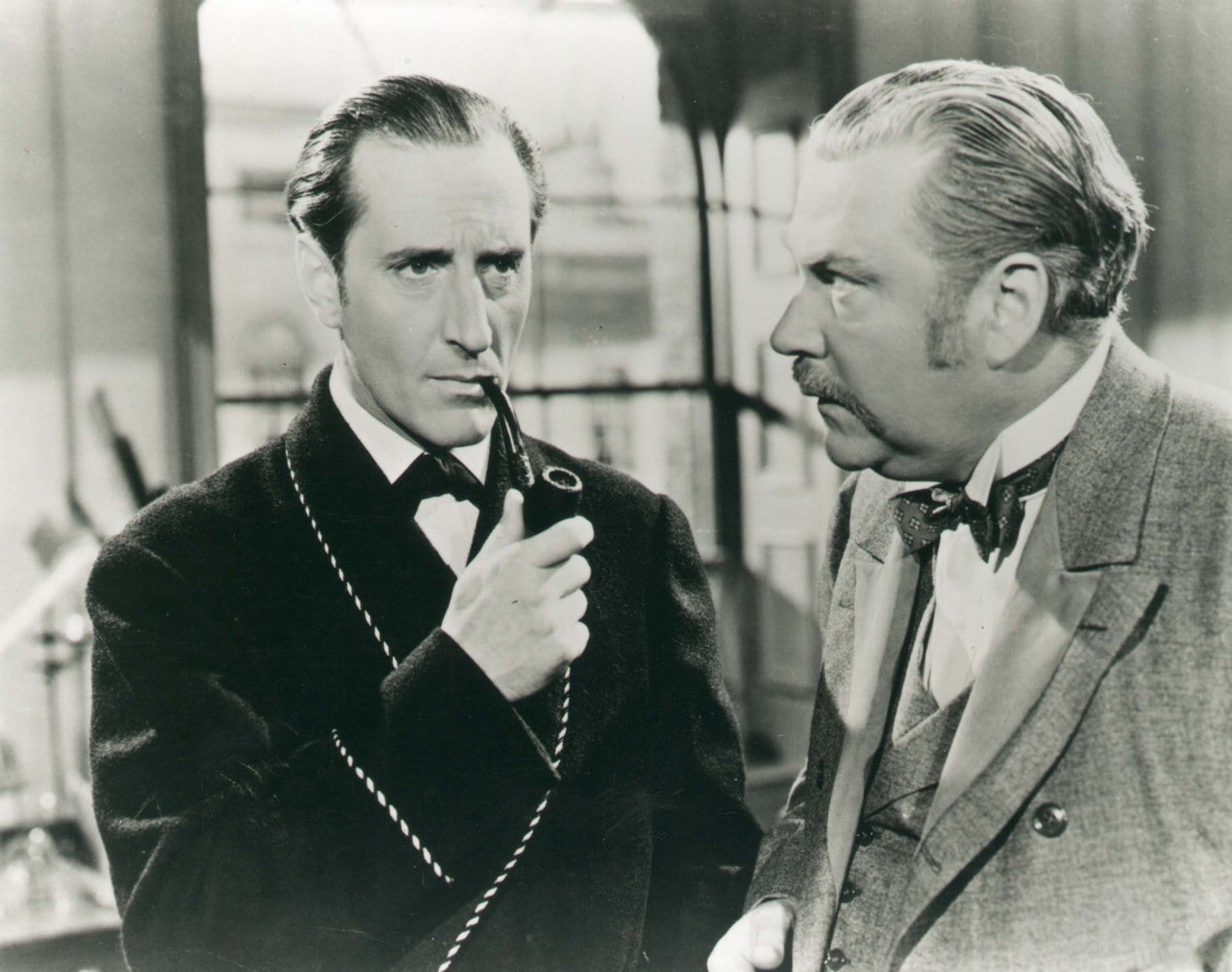Marshall Lichtman
Rochester, New York, United States
 |
|
Figure 1. Basil Rathbone (Sherlock Homes) with pipe and Nigel Bruce (Dr. John H. Watson). A scene from the film “The Adventures of Sherlock Holmes” in 1939. The plots rarely adhered to the Conan Doyle story plots and Inspector Lestrade of Scotland Yard and Dr. Watson were portrayed as bumbling, quite different from the Conan Doyle stories. But, Rathbone was brilliant and set the model for Holmes’s character thereafter. Alamy Images. |
My colleague and friend, Professor Seymour I. Schwartz, a distinguished surgeon and academician, has chronicled the careers of over 100 physicians who were notable writers in his monograph From Medicine to Manuscript: Doctors with a Literary Legacy.1 These physician-writers ranged from Maimonides to John Locke to John Keats to Anton Chekhov to Somerset Maugham to William Carlos Williams to Michael Crichton. Included, was a singular physician-author, Sir Arthur Ignatius Conan Doyle, the creator of the most compelling and enduring character in fiction, Sherlock Holmes.
Conan Doyle was born in Edinburgh, Scotland in 1822. Throughout his early education he had an interest in literature, editing and writing for a student newspaper in secondary school. At age seventeen he began his study of medicine at Edinburgh University. One of his lecturers and teachers, Joseph Bell, a surgeon known for his deductive skills in diagnostic medicine, captured Conan Doyle’s imagination and is considered the inspiration for the most famous detective ever created, Sherlock Holmes. Conan Doyle had a barely sustainable medical practice and survived from the proceeds of his writing. In 1886, he wrote his first Holmes story, “A Study in Scarlet,” which was rejected by the first magazine to which it was submitted, but accepted by the second, Beeton’s Christmas Annual for 1887, earning Conan Doyle the inconsequential sum of 25 pounds for the complete copyright. His second Holmes story “The Sign of Four” was published in the English and American editions of Lippincott’s Monthly Magazine in 1890.
Conan Doyle tried to bolster his medical practice by spending several months in Paris and Vienna studying to become an eye specialist. On his return from the continent, he established his office and residence in Russell Square, London. This effort to rejuvenate his medical career was also a failure. Having by this time written several novels, collections of short stories, and two episodes of Sherlock Holmes, he gave up medicine and turned exclusively to writing. In 1881, he published six short stories in the Strand Magazine featuring Sherlock Holmes and his friend and assistant, Dr. John H. Watson: “Watson” to Holmes. Watson was the first-person narrator of all but four of the Holmes stories. These short stories quickly caught the attention and devotion of his readers and of the literary world. Conan Doyle wanted to turn his writing to other genres, but the public clamored for more and the Strand Magazine enticed him with a lucrative contract to provide six additional Holmes short stories. A nemesis of Holmes’ was the ingenious and villainous character, Professor of Mathematics James Moriarty, who is a mastermind of crime, described by Holmes as the “Napoleon of Crime.” Although he only appears in two short stories and dies in the first by falling over Reichenbach Falls in the Swiss Alps during a tussle with Holmes and is mentioned in the second, posthumously, he is so extraordinary a figure that he is indelibly associated as Holmes’s archenemy. He is also the mirror image of Holmes, a genius, but devoted to committing crimes, not solving them. The story in which Moriarty goes over the falls to his death implies that Holmes did as well, giving his life to rid the world of the evil genius. Conan Doyle was tired of these short stories and of Holmes; he wanted to move on to novels and more diverse and serious writing.
The uproar from his readership was such that he had to bring Holmes back to life. Fortunately, Holmes’s death in the Alps had been left ambiguous.
Conan Doyle was influenced by the advances in science at the height of the Victorian Age. He introduced the magnifying glass in the first Holmes short story and throughout the series featured skills of deductive reasoning, the ability to accumulate obscure clues and weave them into a fabric of explanation. His use of forensics, including analytical chemistry, toxicology, ballistics, and extraordinary skills of observation, reflecting the advances in science and the application of logic and the scientific method, were intrinsic to the stories. In the end, Conan Doyle published 239 literary works, but his fifty-six short stories centered on the idiosyncrasies, genius, and detective skills of Holmes gave him his enduring reputation. Holmes has been replicated and imitated in books, radio dramas, movies, theater, and television programs for over a century and is the most famous literary figure ever created. There are board games and animal detectives emulating Holmes. This captivation with Holmes and his repeated recreation represents the unsurpassed longevity of any fictional character from literature. Holmes has been examined as a real person and a serious attempt to calculate his IQ has resulted in a figure of 190. The Baker Street Irregulars, founded in 1934, remain eighty-six years later an active source for all matters relating to Holmes (visit their website). Sherlockians, devotees of all things Holmes, can be found throughout the world. Holmes’s fictional address at 221b Baker Street is now The Sherlock Holmes Museum on Baker Street in Marylebone, London NW1 6XE, United Kingdom and, nearby, at the Baker Street tube station stands a statue of Holmes in classic garb holding a pipe. A larger than life-sized statue of a fictional person! Remarkably, four other statues of Holmes exist, one in Meringen, Switzerland, below Reichenbach Falls, one in Karuizawa, Japan, one in Edinburgh, Scotland, at Conan Doyle’s birthplace, and one in Moscow, near the British Embassy. The latter, also, has the figure of Dr. Watson looking on. There have been innumerable television series and movies dating from 1900 in which Sherlock Holmes is the central figure and hero. For my generation, Basil Rathbone and Nigel Bruce, the prolific British actors, in their movie portrayals gave Holmes and Watson their classic appearance, mannerisms, and style. (Figure 1) They, also, reprised the Holmes stories in over 200 radio dramas. Holmes was even projected into the 1940’s aiding the British effort against the Third Reich. Sherlock Holmes is the most enduring and imitated literary character in history. He has so captivated the readers of these stories and his life and times and his persona are so vivid that for many it is difficult to remember that he is fictional.
 |
 |
| Figure 2. The Sleuth of Baker Street bookstore, Toronto, Ontario, Canada. Images courtesy of J D Singh | |
Epilogue
In Toronto, Ontario, Canada, on Millwood Street, resides one of the great bookstores devoted to the genre of mystery and detective stories, The Sleuth of Baker Street, an homage to the greatest of them all—Conan Doyle and his creation Sherlock Holmes. (Figure 2) The store is small, books on shelves from floor to ceiling and on tables occupying most of its floor space; it has one of the greatest collections of writers of mysteries from around the world. On our visits to Toronto, my wife, Alice Jo, and I would always visit it. We were introduced to many writers of mysteries and detective fiction heretofore unknown to us, many in the English Commonwealth, from Canada, Australia, and England among others; writers we would have never encountered otherwise.
Moreover, its ambiance is conducive to exploration, and what an on-point name for a bookstore exclusively focused on mystery and detective story writers. Despite the annihilation of the small bookstore by Amazon Books and its replicas, The Sleuth of Baker Street survives and we hope thrives. Its newsletter is full of gems. The store itself is full of treasures, out of print material, and a willingness to find what one wants. Visit it on the WWW, talk to it via email. Relish its enormous and varied stock of mysteries.
Reference
1. Seymour I. Schwartz. From Medicine to Manuscript: Doctors with a Literary Legacy. Prometheus Books, Amherst, NY 2018
MARSHALL A. LICHTMAN, MD, is professor emeritus of medicine (hematology-oncology) and biochemistry and biophysics at the University of Rochester and a member of the James P. Wilmot Cancer Institute at the University. He is dean emeritus of the school of medicine and dentistry and has received the Wallace H. Coulter Award for lifetime achievement by the American Society of Hematology.
Highlighted in Frontispiece Volume 14, Issue 1 – Winter 2022
Summer 2020 | Sections | Literary Essays

Leave a Reply